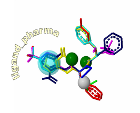 Library ligand_pharma
Library ligand_pharma Library ligand_pharma
Library ligand_pharma[ Keywords | Classes | Data | Functions ]
 Back to the top of ligand_pharma
Back to the top of ligand_pharma
| enum | CARBOXY_ESTER_TYPE ; |
| enum | FEATURE_TYPE ; |
| enum | HYBRIDIZATION_TYPE ; |
| enum | ELEMENT ; |
| define FEATURE_STAMP_LENGTH | 20 |
| typedef char | FeatureStamp[FEATURE_STAMP_LENGTH]; |
| enum | USER_FEATURE_TYPE ; |
 Back to the top of ligand_pharma
Back to the top of ligand_pharma
| bool | reconstructTree(Cell& cell, PairwiseResult& result, vector< BPNode*>& orderedBPNodes, int treeNum); |
| bool | reconstructTrees(vector< PairwiseResult>&results, vector< BPNode*>& orderedBPNodes, unsigned int resultsNum, PairwiseResult templateRes); |
| void | bestKTrees(vector< BPNode*>& orderedBPNodes, int K); |
| double | calculateRMSD(const vector< Vector3>& mol1, const vector< Vector3>& mol2); |
 Back to the top of ligand_pharma
Back to the top of ligand_pharma
bool reconstructTree(Cell& cell, PairwiseResult& result, vector< BPNode*>& orderedBPNodes, int treeNum);
#include "BestTrees.h"
bool reconstructTree(Cell& cell, PairwiseResult& result, vector< BPNode*>& orderedBPNodes, int treeNum);
 Back to the top of ligand_pharma
Back to the top of ligand_pharma
bool reconstructTrees(vector< PairwiseResult>&results, vector< BPNode*>& orderedBPNodes, unsigned int resultsNum, PairwiseResult templateRes);
#include "BestTrees.h"
returns true if ALL possible trees were constructed within the K we asked for
bool reconstructTrees(vector< PairwiseResult>&results, vector< BPNode*>& orderedBPNodes, unsigned int resultsNum, PairwiseResult templateRes);
 Back to the top of ligand_pharma
Back to the top of ligand_pharma
void bestKTrees(vector< BPNode*>& orderedBPNodes, int K);
#include "BestTrees.h"
void bestKTrees(vector< BPNode*>& orderedBPNodes, int K);
 Back to the top of ligand_pharma
Back to the top of ligand_pharma
enum CARBOXY_ESTER_TYPE ;
#include "CarboxyEsterFeature.h"
This enum defines the different types of a carboxy ester feature - Lactone: O=C-O-C where C-O-C are on a ring - Carboxy Aryl-Ester: O=C-O-C not on a ring - P Variant Carboxy Ester: 1. P connected to 4 oxygens in 3 single bonds and 1 double bond: O O-P=O O C 2. P connected to 3 oxygens in single bonds and 1 double bond to S O O-P=S O C - Thio Lactone: O=C-S-C where the C-S-C are on a ring - Thio Aryl Ester: O=C-S-C where the C-s-C are not on a ring
NOTE: The order of the different types is according to their priority, where lactone is the most important type. Also, the type values correspond to their score weights.
enum CARBOXY_ESTER_TYPE {LACTONE = 4,
CARBOXY_ARYL_ESTER = 3,
P_VARIANT_CARBOXY_ESTER = 2,
THIO_LACTONE = 1,
THIO_ARYL_ESTER = 0};
 Back to the top of ligand_pharma
Back to the top of ligand_pharma
double calculateRMSD(const vector< Vector3>& mol1, const vector< Vector3>& mol2);
#include "Evaluator.h"
double calculateRMSD(const vector< Vector3>& mol1, const vector< Vector3>& mol2);
 Back to the top of ligand_pharma
Back to the top of ligand_pharma
enum FEATURE_TYPE ;
#include "Feature.h"
enum FEATURE_TYPE {HYDROPHOBIC = 0, AROMATIC = 1, hDONOR = 2, hACCEPTOR = 3, POSITIVE = 4, NEGATIVE = 5, USER_DEF = 6, NUM_OF_FEATURE_TYPES = 7};
 Back to the top of ligand_pharma
Back to the top of ligand_pharma
enum HYBRIDIZATION_TYPE ;
#include "LigandMolecule.h"
Different Hybridization types of an atom
enum HYBRIDIZATION_TYPE { SP, SP2, SP3, UNKNOWN_SP };
 Back to the top of ligand_pharma
Back to the top of ligand_pharma
enum ELEMENT ;
#include "Mol2Atom.h"
The periodic table elements
enum ELEMENT {CARBON, NITROGEN, PHOSPHORUS, HYDROGEN, FLUORINE,
CHLORINE, BROMINE, IODINE, SILICON, OXYGEN,
SULFUR, SODIUM, POTASSIUM, CALCIUM, LITHIUM,
ALUMINUM, HALOGEN, IRON, FERRUM = IRON,
MAGNESIUM, CHROMIUM, MANGANESE, COBALT,
COPPER, ZINC, SELENIUM, MOLYBDENUM,
TIN,UNKNOWN_ELEMENT };
 Back to the top of ligand_pharma
Back to the top of ligand_pharma
define FEATURE_STAMP_LENGTH 20
#include "MultipleResultCluster.h"
#define FEATURE_STAMP_LENGTH 20
 Back to the top of ligand_pharma
Back to the top of ligand_pharma
typedef char FeatureStamp[FEATURE_STAMP_LENGTH];
#include "MultipleResultCluster.h"
typedef char FeatureStamp[FEATURE_STAMP_LENGTH];
 Back to the top of ligand_pharma
Back to the top of ligand_pharma
enum USER_FEATURE_TYPE ;
#include "UserDefFeature.h"
enum USER_FEATURE_TYPE {UNSPECIFIED_USER_FEATURE_TYPE, CARBOXY_ESTER};
 Back to the top of ligand_pharma
Back to the top of ligand_pharma
Report problems to jkotula@unimax.com